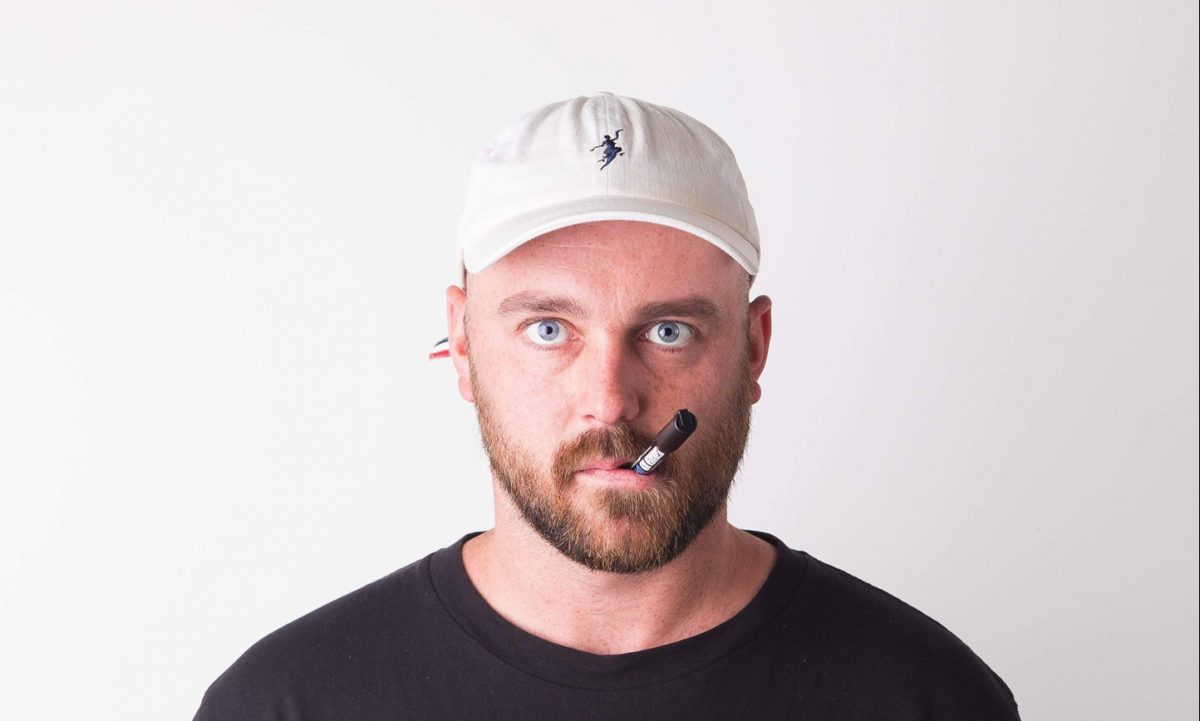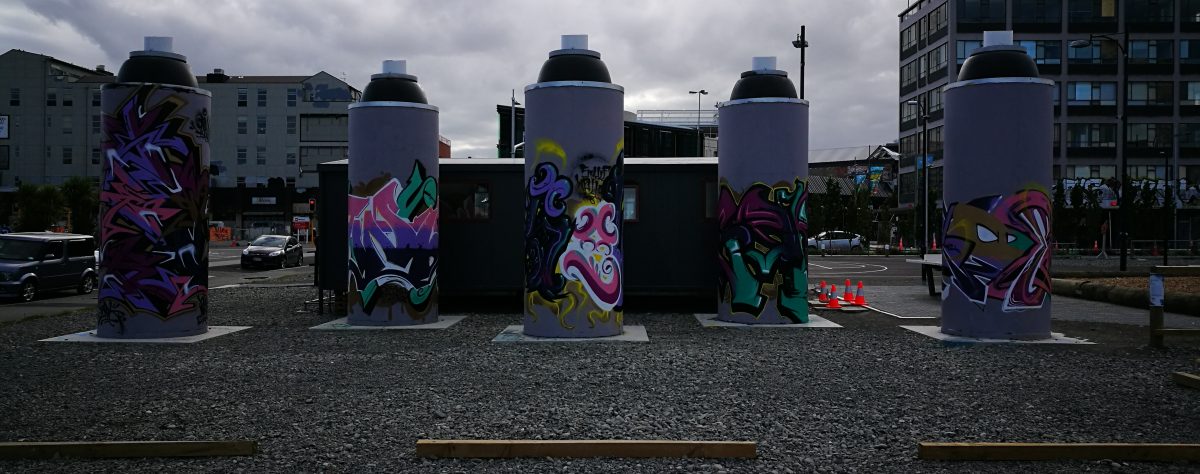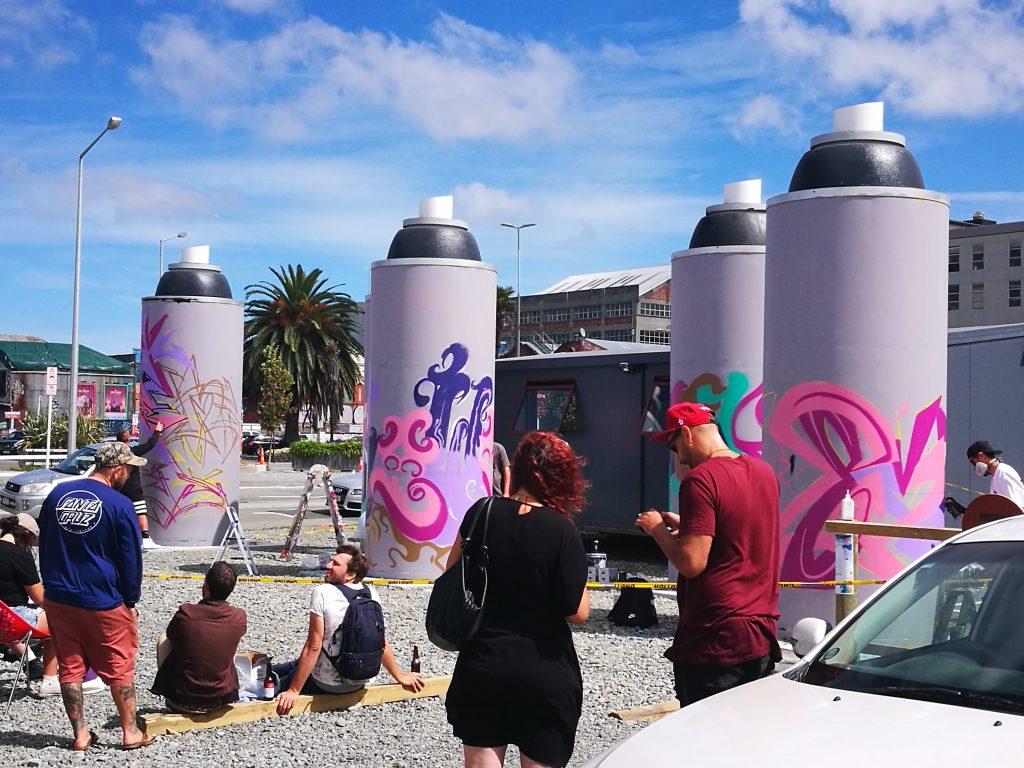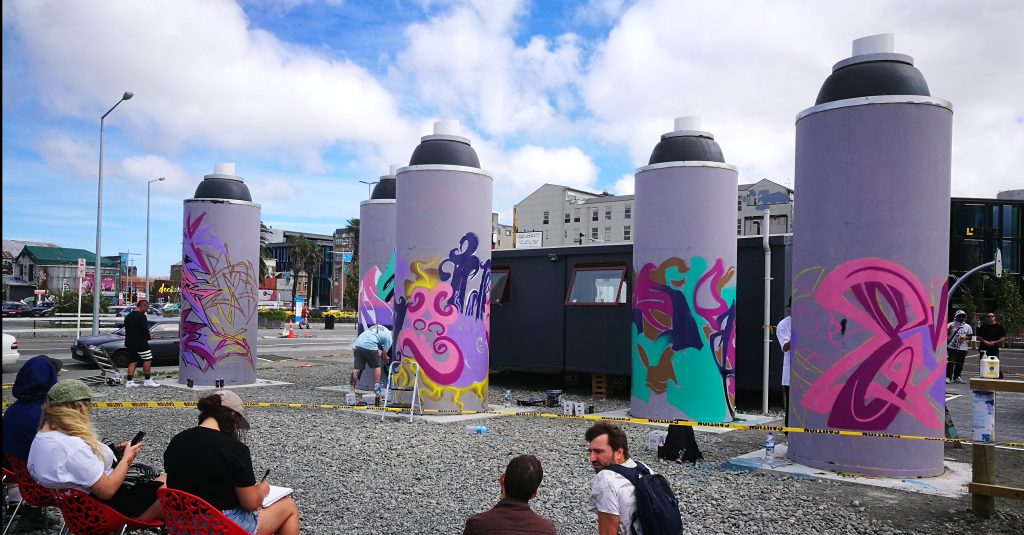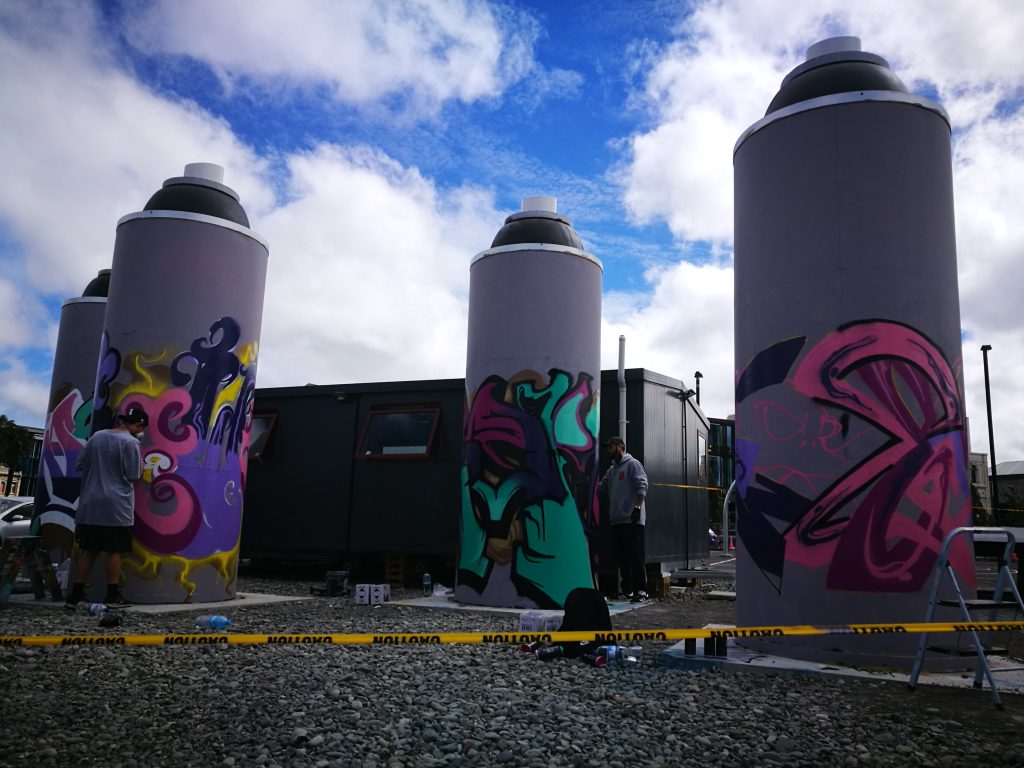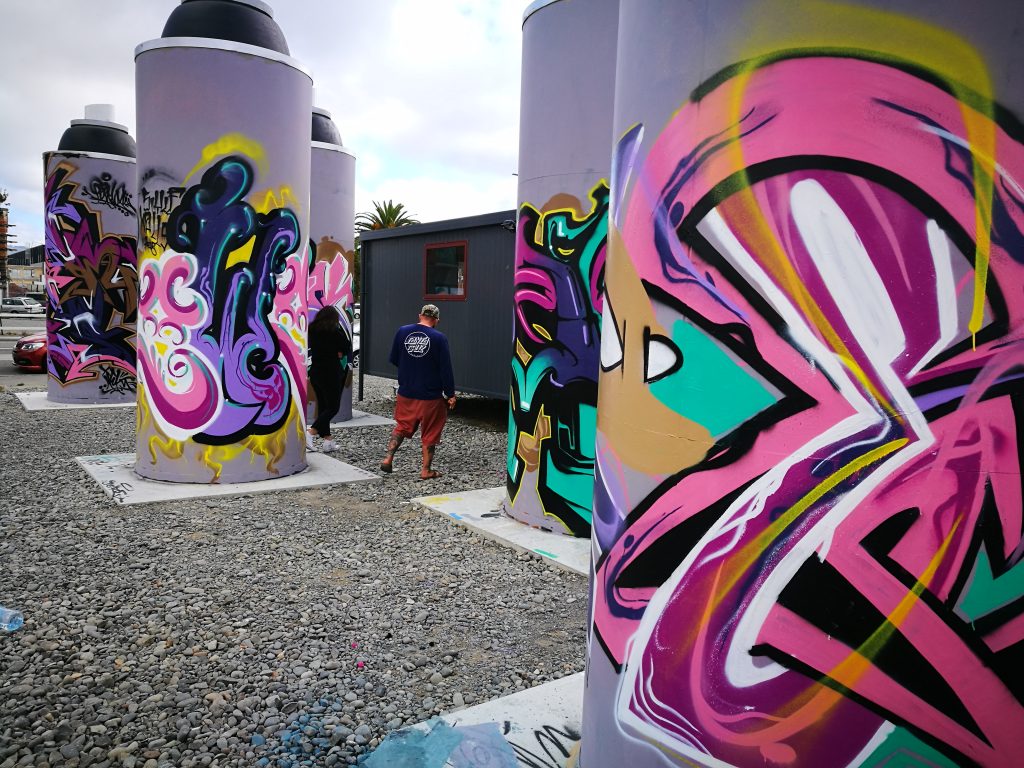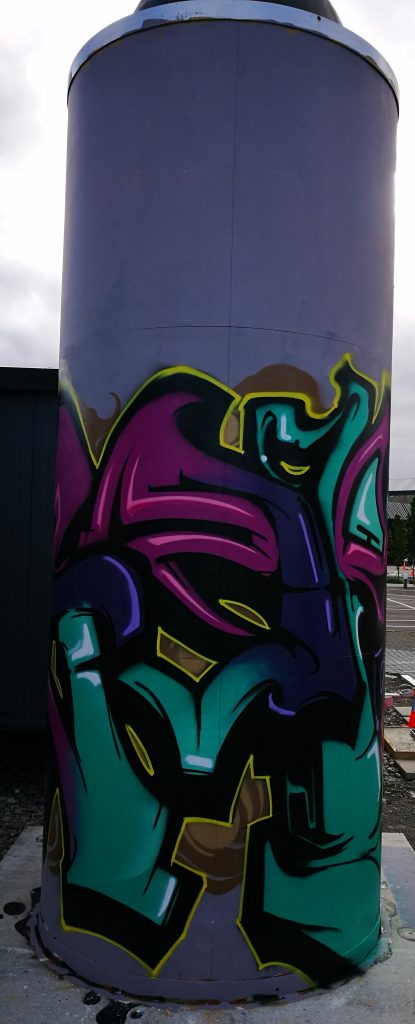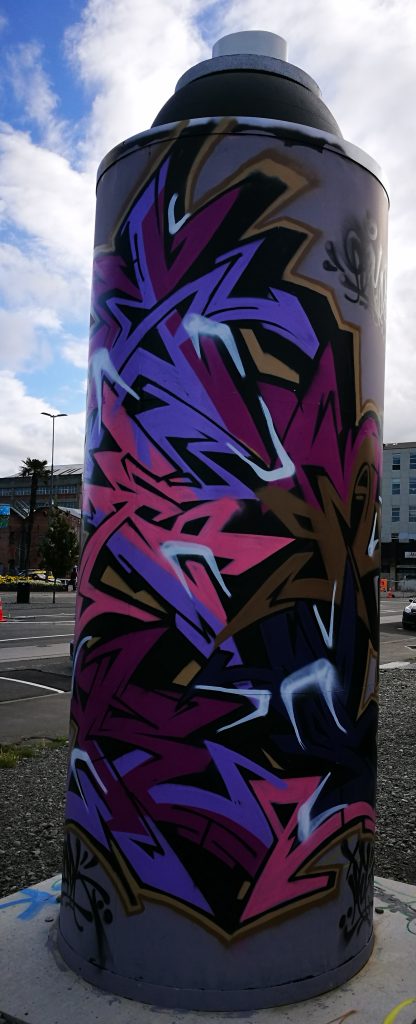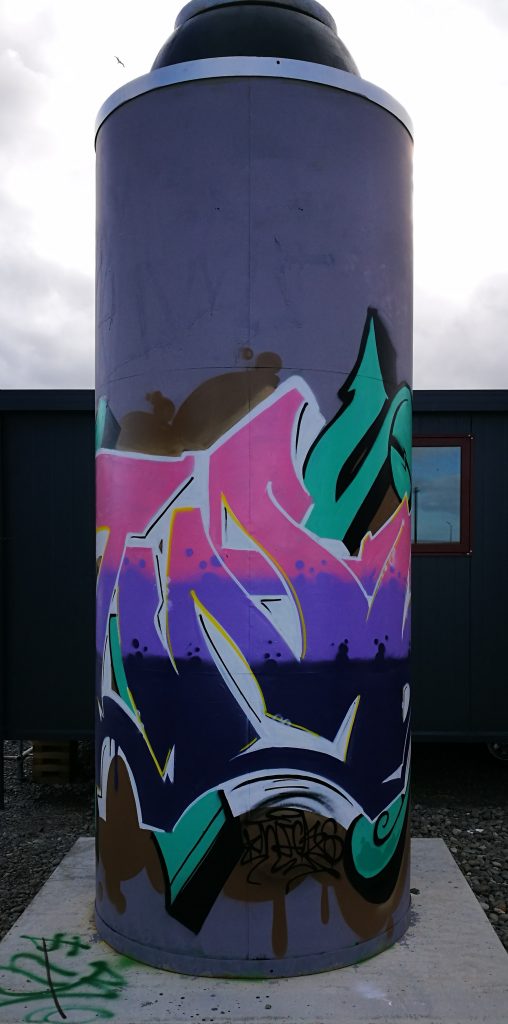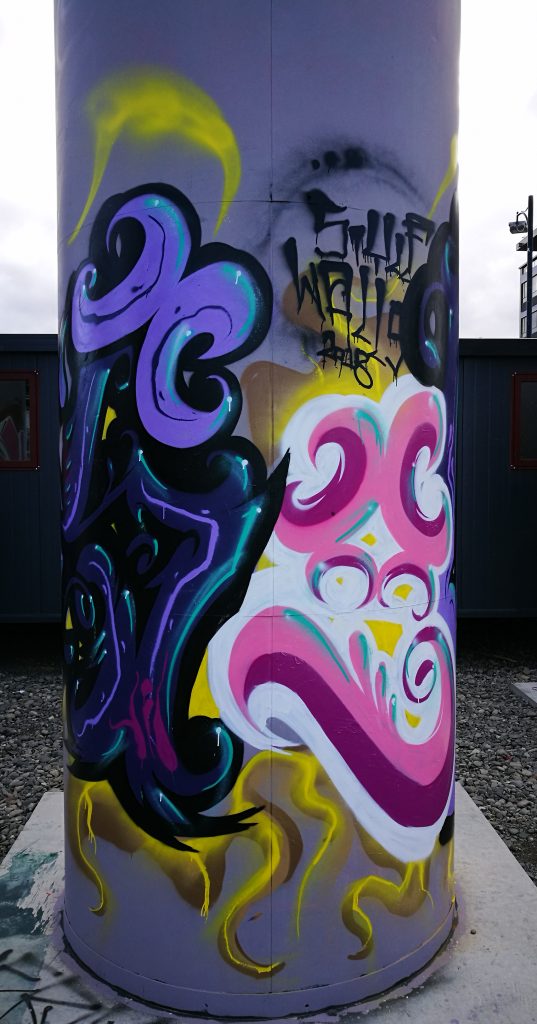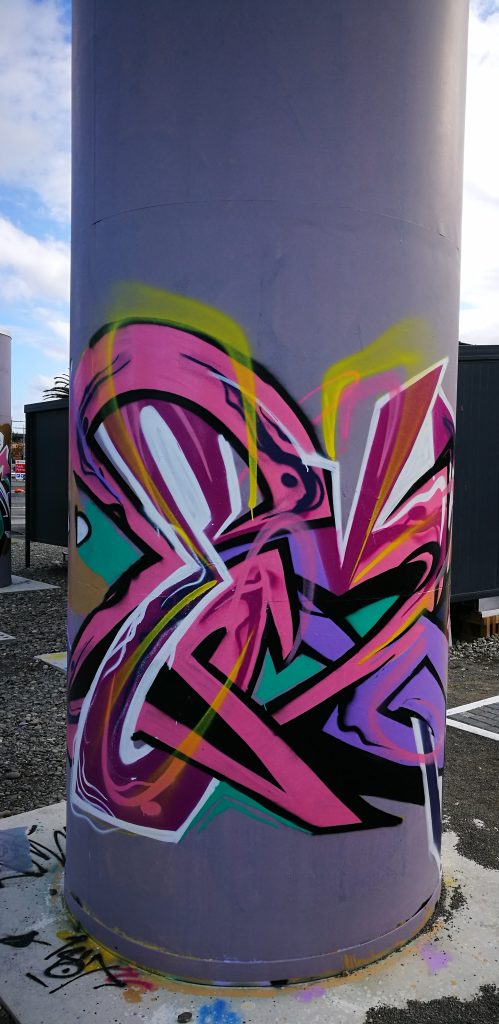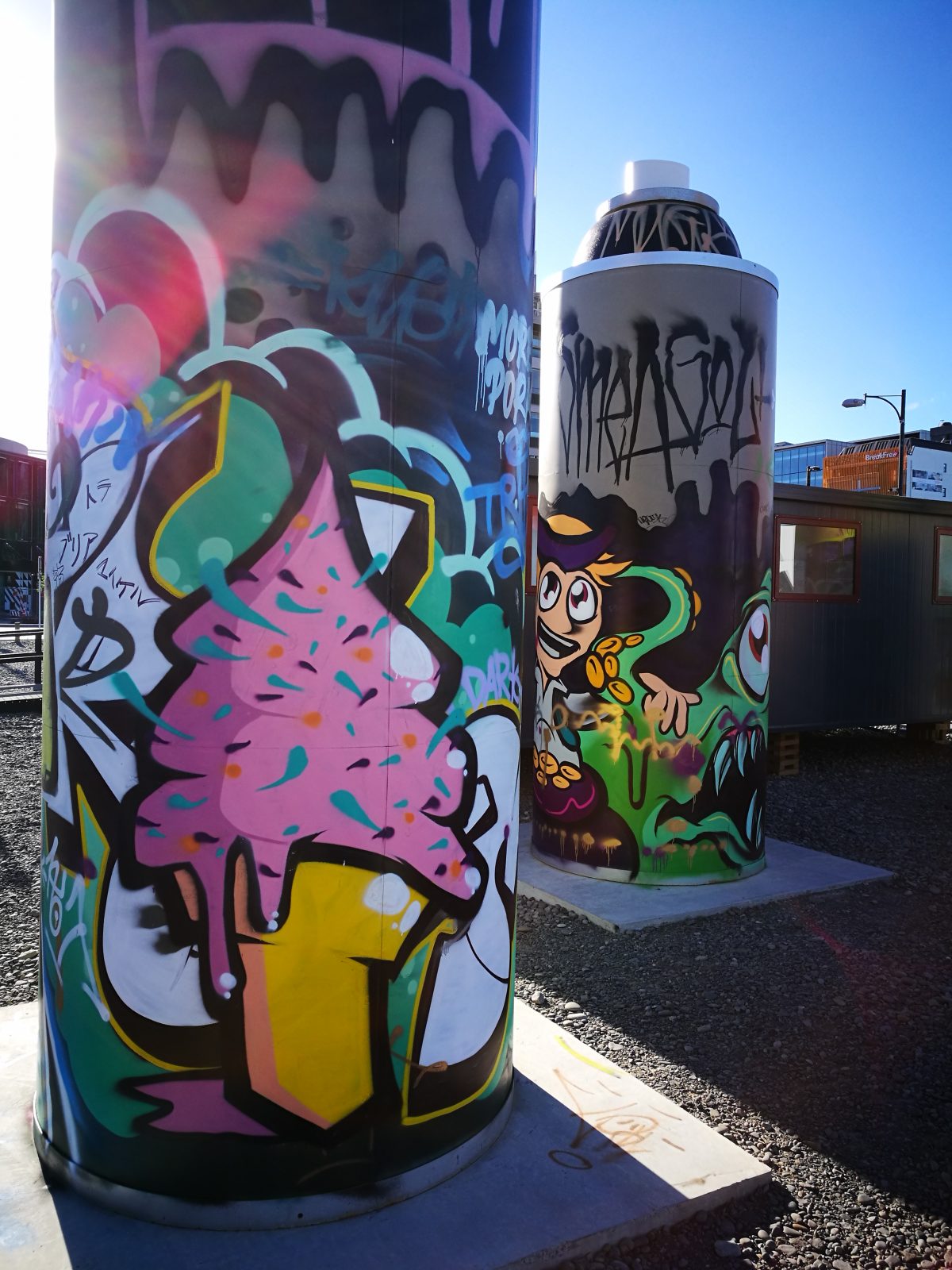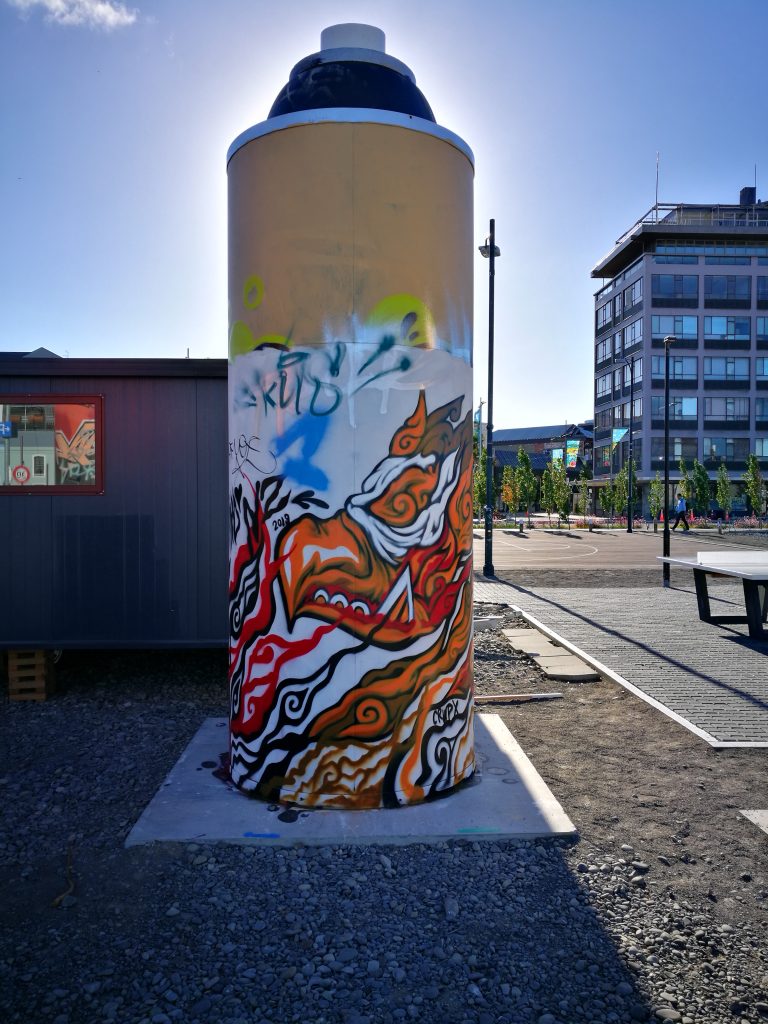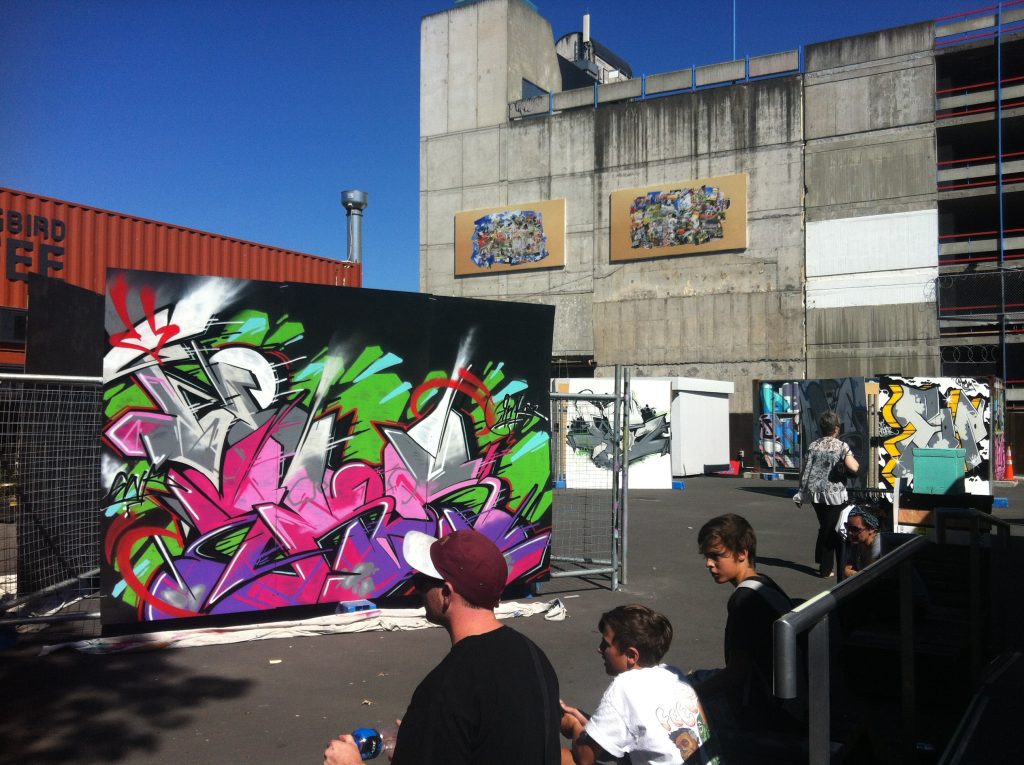Chances are you know Uncle Harold’s work, maybe from various exhibitions, perhaps from his recent advertising campaign with Amazon Surf and Skate stores. Although his work doesn’t have a traditional street presence, it is undeniably influenced by graffiti, street art, and most importantly, skateboarding, illustrating the infiltration of urban art within diverse contemporary artistic practices, and perhaps the rise of the expansive term ‘urban contemporary’. Uncle Harold, sometimes known as Josh Bradshaw, has quickly gained a profile in the Christchurch scene, his distinctive paintings and drawings melt away our expectations, objects literally drip from the wall, from retro shoes to coat hangers, from urban elements to iconic logos. The bright, flat colours add to the hyperreal quality of his creations, ensuring they are playful but also suggestive of the need to look again, to look closer, to see things in new ways. We caught up with Uncle Harold outside his ‘home base’ of the Welder Collective, to discuss the influence of skateboarding, street art, his decision to pursue his art full time, the opportunities for creative people in Christchurch, and Consequential, his up-coming show at the Welder…
So, in terms of making art full-time, you are somewhat new to this right? How long have you been totally focused on making art?
Totally focused, like full-time, since mid-October last year, so, like four and a half months now. I think I’ve been taking it more seriously now for a year, but in terms of a full-time commitment, about four and a half months.
How did the Uncle Harold alias come about? Is it an intentional idea to separate yourself from Josh and instead have another identity, or is it just something playful?
It always was intended just to be playful, the name, I was pretty obsessed with old fashioned elderly people names, like Mavis and Edna, that kind of stuff, so that was where the Uncle Harold thing came from. It honestly just makes me laugh every time I see it written somewhere, especially when I see it somewhere quite formal or for a serious art event, when there are lots of fancy words thrown about and then there’s just Uncle Harold, it makes me laugh so much… I try not to take anything too seriously with art, it’s supposed to be fun, especially the drippy style, and the whole Uncle Harold thing just fits really well with that, not taking anything super serious. It’s quite nice to have someone to blame stuff on, that wasn’t Josh, that was Uncle Harold, blame him!
Do you see it having a natural lifespan that you then might reconsider? Or will you keep running with it?
I think I will keep running with it. I was actually thinking about that, I saw something about another artist who went and changed his name and became more serious, but I definitely can’t see that happening anytime soon, I’m still going to run with Uncle Harold for a while yet…
Have you always been a maker of things?
Making stuff has always been there, from back from when I was a young kid making skateboard ramps and stuff like that with my dad. I always liked art and stuff like that at school, but I was a terrible student (laughs) and I sort of lost it for a bit. But there was a time when I was not up to much, so I thought I would pick up the paint brush again and that’s when I started getting back into it fully a few years ago…
So, you would class yourself as fully self-taught?
Absolutely, fully self-taught. I have no formal training at all, it’s all just trial and error for me…
Do you think that makes you more fearless in how you go about things? You’re not beholden to doing things in a certain way, it’s more a case of just giving it a go, taking an idea and running with it…
One of my favourite things is that I don’t have to follow any rules of art, because I don’t know them! So, it all comes down to what I think and feel looks cool and what works. I don’t know if it is technically correct or not, but that’s how I see things, so that’s how I make my work. I almost feel sorry for people who have to watch me make something, it must be frustrating! ‘Mate you’re doing it wrong!’ (Laughs) But that’s what I like about it, it’s cool…
Your other background is skateboarding; how big an influence has that played in terms of that trial and error approach? Has the skateboarding attitude of trying and perfecting a trick over and over again played into your process of making art?
Yeah, absolutely, everything, everything I know, one hundred per cent comes from skateboarding. Like I say, I didn’t know any artists, I didn’t go to any schools or anything like that, everything I know about art and how to do stuff has come from skateboarding. The art I saw was on the bottom of my skateboard. I wasn’t in a gallery looking at anything, it was just what I had under my feet and then that determination of trying something until you do it and not caring about what anyone says or anything, so that has transferred over to my art…
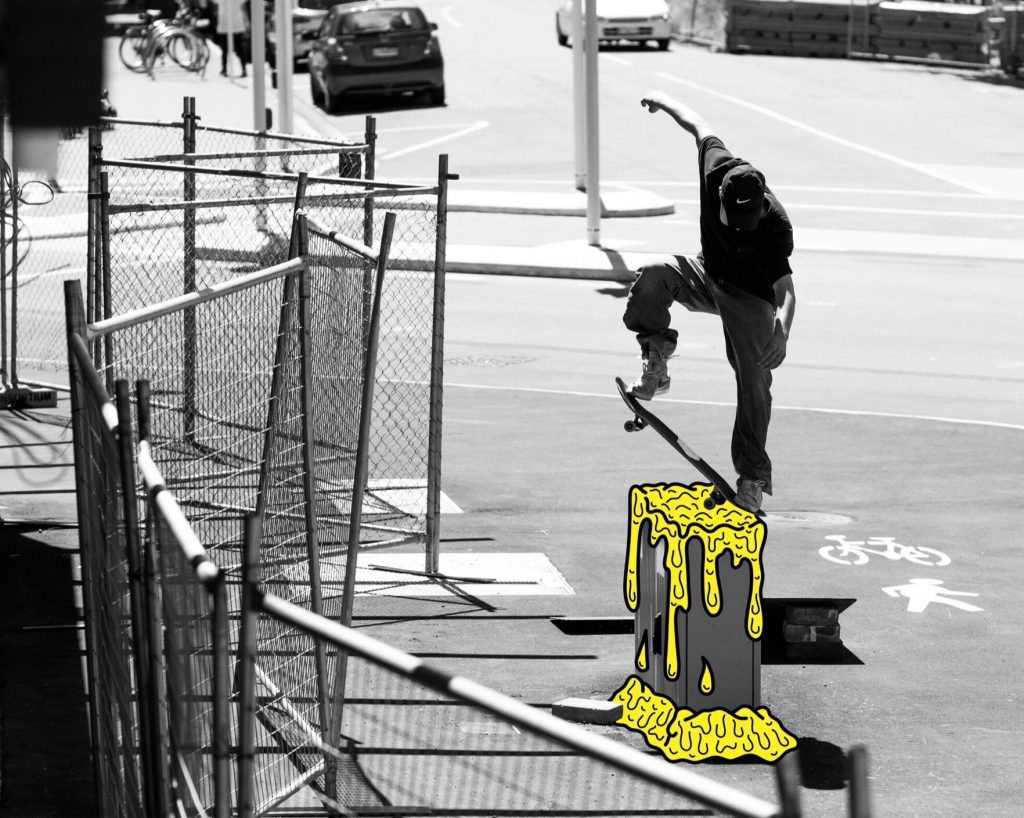
Although you’re not working in the streets explicitly, it feels like your work shares a kinship with urban art and street art, and I’d suggest it ties back to the fact that skateboarding is such a big influence because that is part of that sphere of urban art…
Yeah, I think there are so many similarities between skateboarding and the dudes on the streets painting walls: you’re somewhere where you shouldn’t be, you’re pissing someone off, you’re running from authorities on occasions. You just have to look around Christchurch, I’ve spent hours out in those sketchy abandoned spots skating an obstacle, but there is a whole wall of street art and graffiti behind me, so I feel like that’s a really heavy influence on that street style.
Street skating, like a lot of street art, is about subverting the urban environment, seeing something in a different light and finding a new use for it, does that element come through in the way you make work as well?
Yeah, that is actually the whole reason behind the dripping stuff; seeing something, seeing the potential of something that isn’t anything. You know, some person walks past a bench and it’s a bench, but I walk past it and see the way the ground goes up to it, the angle it’s on, like all that stuff. Everything I paint is about seeing it in a different way than it actually is, subverting these objects…
So, by kind of melting away the façade of objects, you are encouraging the viewer to re-think the object and their take on it?
Yeah definitely, the basic point of it is everyone sees things differently, we can all look at the same thing and everyone will take something different away from it, whether it be the colours, or which parts are dripping…
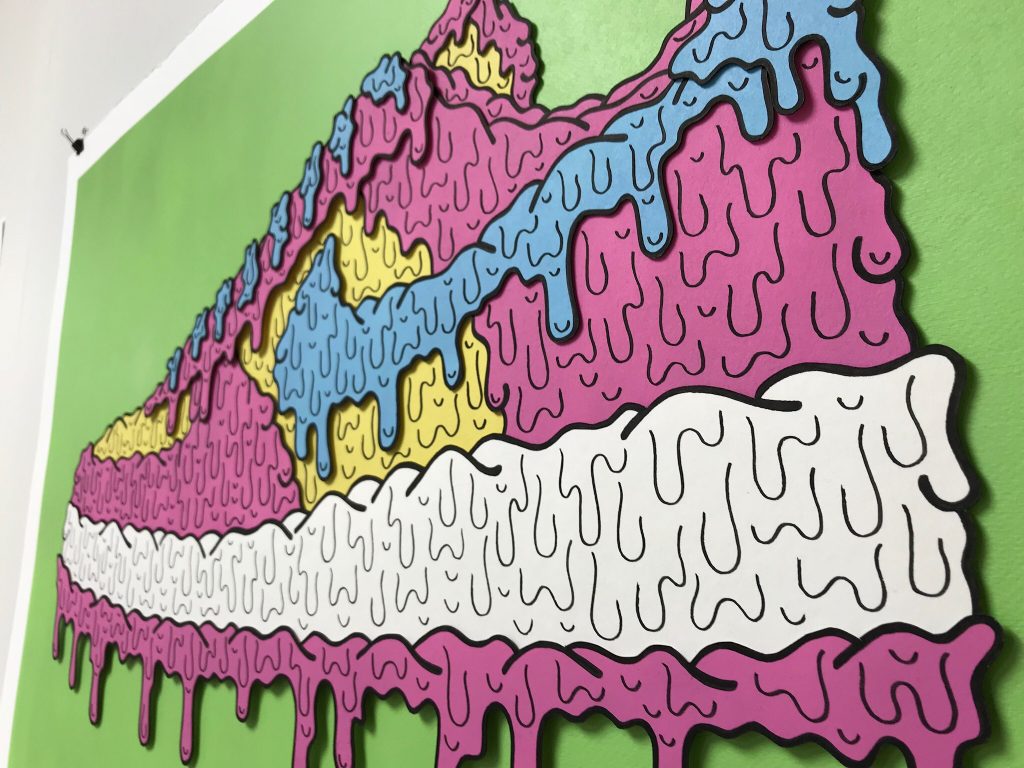
Which means you can take any object, right from the smallest, most mundane things, like lighters and pens, things that we handle all the time and we often take for granted in many ways, and by transforming them, we become more aware of our relationship with them…
Yeah, I’m a huge fan of making something interesting out of the most boring, everyday sort of stuff we take for granted. You take something you use every day, and you make it into something cool because no one really sees that stuff, you look at it, but you don’t really see it.
We don’t pay attention to it…
Yeah
So, by subverting it, by changing it, we are forced to reconsider it’s various qualities, both physical and in a sort of associative, experiential way as well…
Yeah
I’ve heard you introduce yourself as the guy who ‘paints the drippy stuff’, which made me chuckle, because it was this really unassuming statement, but it revealed your recognition of how it has become your signature, you must now have a process, do you have a certain way of essentially melting an object?
Once I’ve decided on the object, and it’s usually always an object, I usually think about it in the order that you see it. So, whatever is closest, those drips will be on top. So, basically, I draw it exactly like it would be in real life, but just completely dripped and melted… (laughs)
Do you ever practice by melting objects?
No (laughs), but I’ve thought about it, and I think I’m going to have a play with something like that pretty soon…
You have found a way to apply this visual concept in a whole range of different media, transforming objects in photographs by painting over the top of the image, but then you’ve also created this three-dimensional approach as well, and that’s extended from paper and card to wood. So, how does that differ, working in the two-dimensional and three-dimensional forms?
Drawing on the photos is actually a lot harder, to find a photo that will actually work with it is quite hard. I’m also very aware that ninety-percent of the time I’m drawing on a photo that isn’t mine, I haven’t taken it, so you have to respect other people’s work, and you have to find a way that it will fit in with the photo and not take anything away from someone else’s work, and yet still allow me to put my touch on it and have it look cool. So, that’s quite hard. The layered pieces, that idea came from my grandmother. She makes Christmas cards and birthday cards, it’s called paper tole I think, and it’s where you basically cut out all the pieces and stack them and they form like pot plants and flowers, and all these delicate, very intricate little things. I was at her house and having a look around one day and I was like, I wonder if I can do that onto my two-dimensional paintings, and I just started cutting them up and layering them and it turned out quite cool…
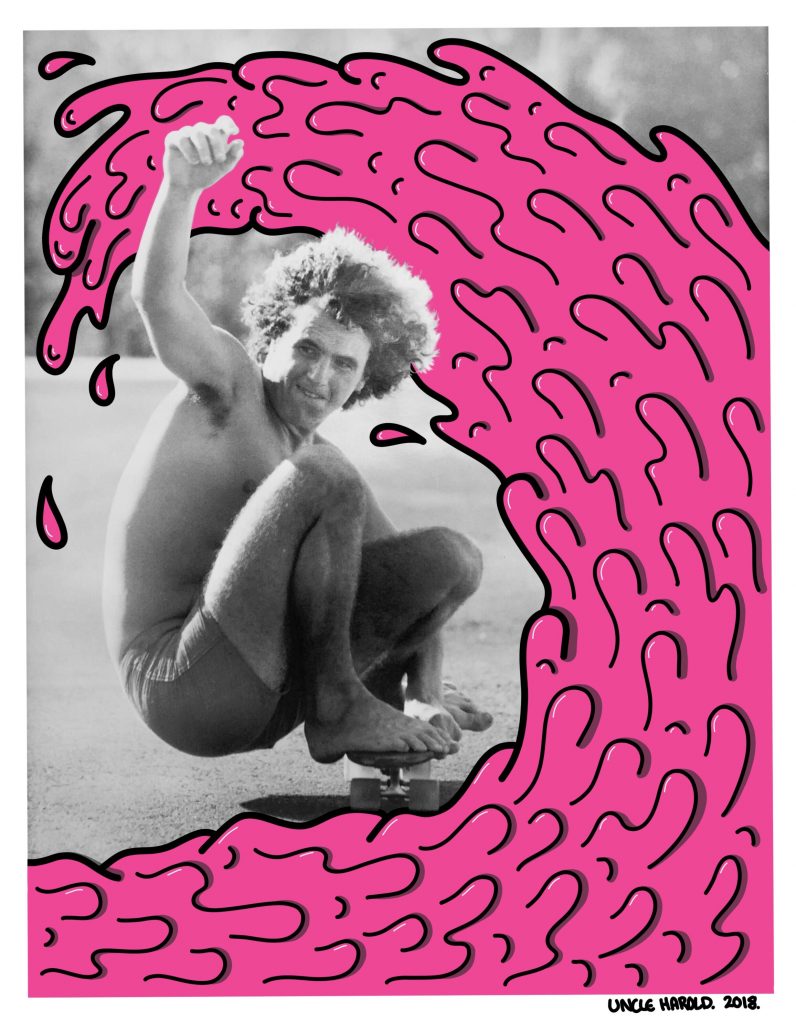
Obviously with paper or card, the ability to cut and shape is quite straight forward, a scalpel will allow quite a bit of maneuverability, what challenges have come up in using wood, which is literally a much harder material?
My whole family are furniture makers by trade, so I’ve always been around people making stuff out of wood, so naturally as a kid I picked up the power tools and the skills in that department. I always wanted to go to wood, to make something a bit bigger. Definitely, cutting all the pieces out is way more intricate, and you have to be careful because they are quite, I don’t know what the word is, some of the drips are quite tight, so getting the jigsaw in and around there is quite tricky, but it’s the same principle as doing it on paper, except you are using some power tools which I’m pretty comfortable with, so it was a pretty natural thing, I always wanted to go there…
They do present different types of tactility though. There is a delicacy to the paper and there is a different sense of bulk and weight to the wood, does that mean different objects are better for different mediums? Do you find that there is a relationship between the object depicted and the medium you choose to use?
Um, I don’t know if there is, I think if I can generally make it out of paper, I can make it out of wood, but you do have to think about it more structurally. If it is wood, it is going to be heavier, you know the workings behind what you see, the actual structural integrity has to be a lot stronger, so it definitely is way more complex…
Some of those more intricate designs, with intricate bridges won’t work though…
Yeah, definitely, you have to go bigger, the bigger it is the easier it is…
Speaking of going bigger, currently your work is largely studio-based, but it has a style that would translate well outdoors, is transferring your work to the streets a logical step?
I think it is a logical step for me, it’s definitely something I’ve been thinking about and I’m really keen to do. I will go outside and paint some bigger stuff, I’m just very aware of the fact that Christchurch is one of the street art capitals of the world now, and there are a lot of street dudes out here that do it regardless, and I’m very aware that a studio artist going out there and just painting walls…
It can be received in a certain way…
Yeah, you know, there are kids out there doing it because they love it, and you don’t want to step on any toes, it’s a respect thing…
That’s an important thing to acknowledge, people tend to believe that you earn you stripes in the streets, but at the same time, with muralism in particular, it is shifting away from some of the older traditions, and it means it’s a more open field, it is now its own thing, and I think those breaks from traditions are more easily accepted. In terms of that relationship to the streets, your approach, of consistently applying and refining and expanding a visual idea, seems very much akin to street art’s fascination with signature styles; developing an approach and an identity through an iconographic imagery. So, was that idea of repetition and recognition something you were aware of?
It was accidental in the way that I started doing the drippy thing, but I obviously started doing it because I liked it, I still love the way it looks, and I like the idea of always figuring out a way to do it but keeping it new, that you can do the same thing and people will recognise it, and you will know what it is, it might not always be the same thing but still keeping elements of that drippy stuff in there. You always want to progress and try new stuff, but it’s also finding that balance, while keeping that identity that you’ve developed for yourself.
Does choosing to work with a distinct visual theme mean you have been aware of the need to keep it dynamic through intentionally evolving the processes, or have any changes been quite organic, a result of playing around?
I think it is organic, it is that whole skateboarder approach: try until you figure it out. Some might not work out, but some definitely will. I do have a lot of ideas for evolving it, it is a natural progression, so it’s quite organic, but I’m very aware that I have to find new ways to do it. I don’t want to be the guy in thirty years, ‘oh that guys still doing that!’ (laughs) ‘It’s boring now!’ (laughs) And for myself, I don’t want it to be boring, so it’s a very natural progression, but I’m aware that there will be some intentional transitions… It’s quite funny, I feel like I’m getting ahead of myself, I’ve already got all these plans, but because this is so new to me, I’m only just starting, people are only just starting to know my stuff, I’m not holding myself back, but still…
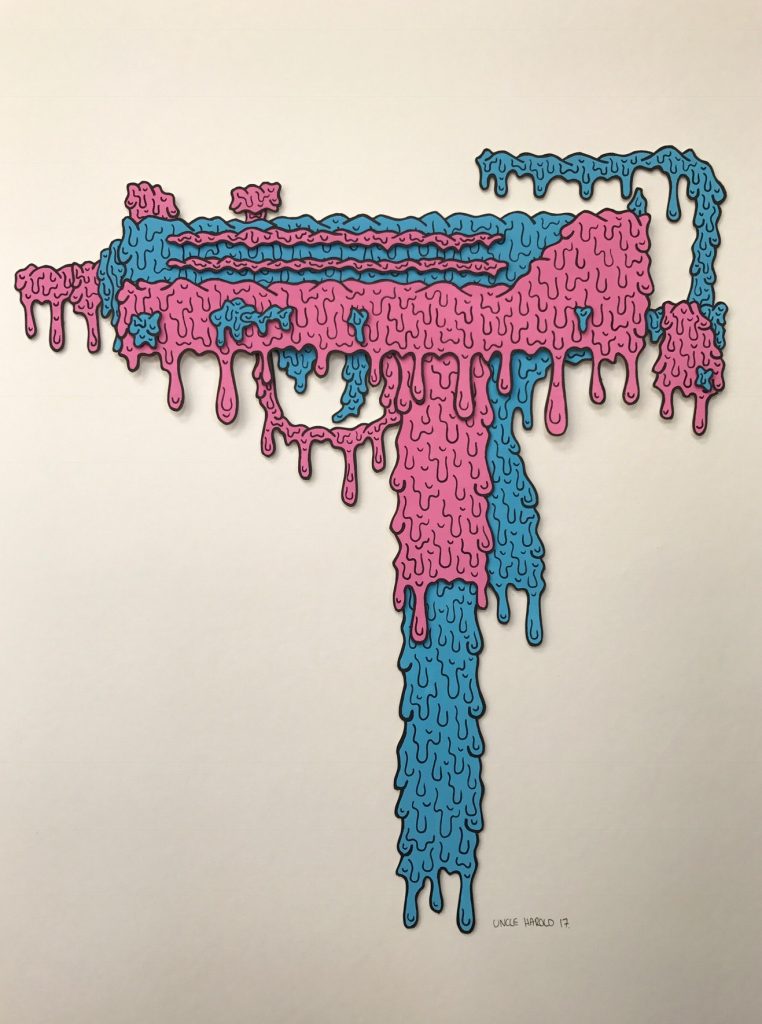
There’s a need to establish yourself…
Yeah, I’m trying to set up and establish myself first before going too far and running out of ideas too quickly…
Your work might be considered a reflection of the growing ‘urban contemporary’ field, and how the footprints of graffiti and street art are now really wide-ranging, with more and more people’s work influenced by these forms, regardless of where and how it is being made. In Christchurch, because we have been given this title as a lively site of street art, do you see that urban contemporary influence becoming stronger?
Yeah, I know from being around ‘fine art’ people, at the Welder Collective and doing those shows, that Canterbury has a pretty rich history of Fine Arts students, but after the earthquakes, you can’t deny it, there is so much of it, the low brow art, the street art, there is so much room for it. It is hugely popular at the moment and there is so much support for lowbrow people to be in those galleries and exhibitions, so you can definitely see the influence from the streets that has popped up, you see so many kids coming out wanting to be in these shows…
Your trajectory is kind of a reflection of some of those the changes, the first place you showed your work was Embassy [the iconic skate and street wear store in Sydenham], and now you are part of the Welder Collective and you have a more specific, dedicated place to work and exhibit, so you must be very much aware of the variety of avenues available…
Yeah, and I think a lot of that has to do with the fact that our central city hasn’t had a lot in it for a long time, so people were fed up and were like: ‘so and so wants to have an art show’, ‘yeah, sick, finally, let’s do something!’ There are so many people who want things to happen and want to jump in and support you. So, you know being anything creative; a musician, a photographer, an artist, I think there is a lot of support, and that it is actually quite easy at the moment to get that backing to do these shows…
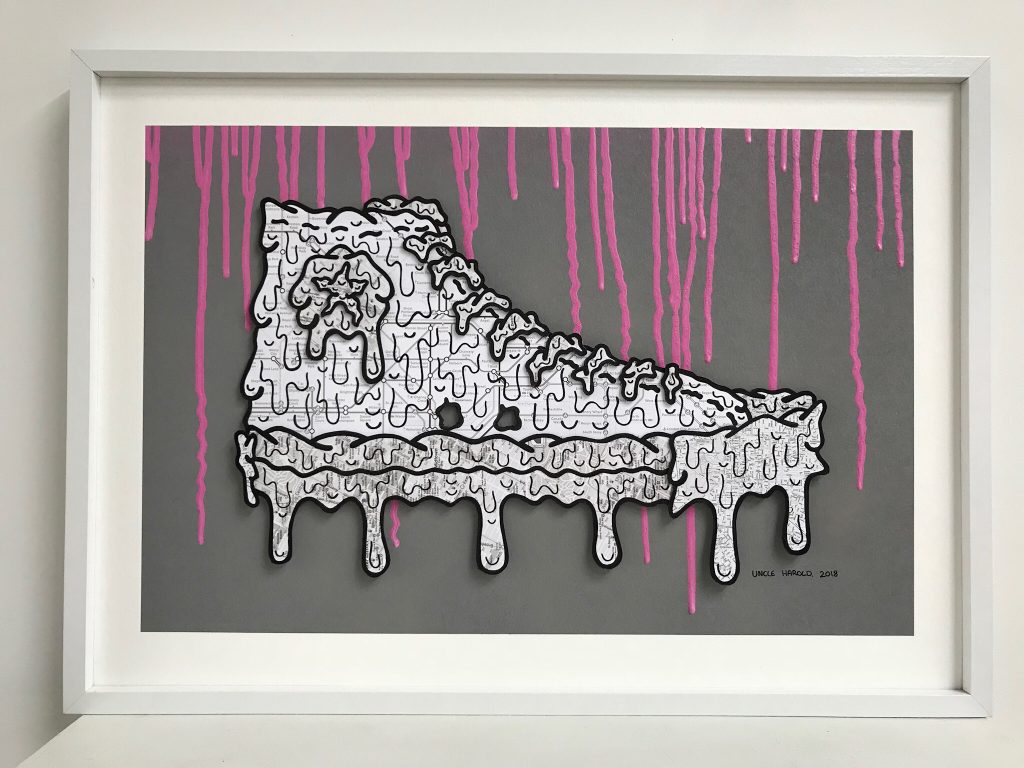
So how did your connection with the Welder Collective come up? How did you end up working here and with this array of creative people?
It’s basically just been a natural progression; you meet someone at an art show or something and it grows from there. Like, I was showing some stuff at Embassy and met someone there who was in this exhibition that I was invited to be part of, then I met someone there who invited me to do something, so all these connections eventually led to someone saying: ‘You should come and check out this space that we have called the Welder’… So, I actually showed up and never really left! They are stuck with me now, I just kind of weaseled my way in! (Laughs)
You have a solo show coming up at the start of March at the Welder, what can people expect and what is the idea behind the show?
It is called Consequential, and it is opening on Friday, March 2nd . Like I was saying, I’m still establishing myself, so this show will be all works on paper, the cut and layered style. But in terms of the theme, it’s really about those standard objects that you overlook that we were talking about. But it’s not about the objects specifically, it’s about the attachments people can form, and whether it’s a lesson taught by someone or something and whether there is an object that can be pulled from that, so it is a lot of everyday objects that have a lot of significance to me personally, so that’s what the whole show is about.
How much of that biographical information do you feel comfortable putting out? Is it enough that you put the work out and the audience make their own connections? Or is it going to be more explicit in how you offer the narrative behind those works?
The nice thing about painting very plain objects is that people can form their own attachments to them. Obviously I’m not explaining exactly what the meaning is behind each thing, but I am putting a zine out that will accompany the show and that will have a wee story or something that gives a brief explanation of what the different objects mean to me, so you can choose to read that if you want to know where I’m coming from, but it’s completely up to you. Each object is standard enough that everyone can form their own attachment to it, like we say, we all look at the same thing and everyone has their own take on it…
And I think with really mundane objects, those stories can range from some really memorable experience, to just some incidental moment, with no apparent significance, simply because they are always around. What are the plans for the next twelve months? Obviously, you had the campaign with Amazon, which provided some pretty big exposure, is there anything else in the pipeline?
Yeah, the Amazon job really opened the door for more commercial work. After that job came out, a few businesses have approached me to do some work with them, so over the next few months there are a couple of exhibitions that I’m part of, but then there will be a lot of commercial commissioned work to come out after that. I’m hoping to plan a show in Wellington for later this year as well.
With those commercial opportunities, were you approached, or did you put dome feelers out?
Nah, I definitely didn’t put any feelers out! They approached me and I’m open to it, you know the starving artist thing, everyone knows that story…
An artist’s gotta eat right?
Yeah, I’m not opposed to taking corporate money to let me do my own stuff…
How differently do you conceive of the commercial stuff to what your doing on a personal level, especially having such a signature, recognisable style? Is there an ethical line you draw in terms of who you work with?
Yeah, you know there will be, you pick and choose your battles to suit your own personal views. I quite like getting a job you might not be too stoked on, but it presents the challenge of taking something and making it cool. If I can go into something I’m not one hundred percent on and turn it into something I really like at the end of it, I actually really like that challenge, so, that’s one way I look at it. I’m not like, ‘oh I’m just going to half-ass it’, if I can make it into something cool then I will happily do it.
Consequential opens at the Welder Collective (Welles Street), Friday March 2nd, 2018 at 5:30pm. You can also check out Uncle Harold’s work in Stoked, at New Brighton’s Fiksate Gallery, March 13th – 19th. Follow Uncle Harold on Instagram: @thejournalofuncleharold, and check out www.thejournalofuncleharold.com for more of his work…
(Feature image photo courtesy of Uncle Harold)

